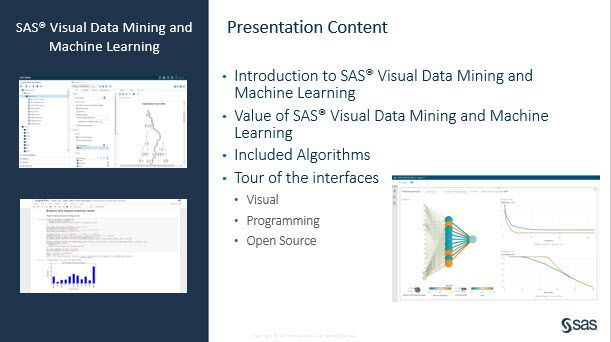SAS Visual Data Mining and Machine Learning (VDMML): Getting Started
Innovative algorithms and fast, in-memory processing. That's what you get with SAS Visual Data Mining and Machine Learning.
Designed for data scientists, statisticians and business analysts, it offers advanced programming capabilities coupled with point-and-click ease.
Watch this presentation and demo as we explore:
- New algorithms - factorization machines and random forests.
- Creating models - neural network and gradient boosting (including auto tuning).
- Comparing models - multiple criterion such as lift, ROC and misclassification.
- Interfaces - Interactive features, programming capabilities and integration to open source.
Here are some highlighted questions from the Q&A segment held at the end of the session.
Does SAS Visual Statistics come with SAS Visual Data Mining and Machine Learning?
As part of the VIYA platform when you license SAS Training Visual Data Mining and Machine Learning you also have SAS Visual Analytics and SAS Visual Statistics
Can I add SAS Visual Data Mining and Machine learning to my current SAS install
SAS Visual Data Mining and Machine Learning is a part of the new VIYA platform. SAS VIYA and SAS 9.4 can be integrated and interact with each other and they are a separate installation and configuration.
Is it possible to download this data?
This data is available with SAS Enterprise Miner as a sample dataset. You can find it in the SAMPSIO library.
Is autotuning available in the Visual Interface?
In the current version of SAS VDMML 8.1 autotuning is available through programming in SAS VIYA or Jupyter Notebooks or through the task in SAS Studio.
Is there integration with R?
Yes, Python, Java, R and Lua are supported. You can call SAS VDMML using your preferred language in our world-class, governed environment. And using REST APIs, you can add the power of SAS Analytics to your custom applications.
Q: Are the algorithms provided in VDMML the same algorithms used in SAS Enterprise Miner?
A: Yes and no. Regression, Decision Trees, Neural Networks, Gradient Boosting and Random Forest are available in both. The implementation however is different. VDMML runs everything in memory so the algorithms are adjusted to take advantage. Also the default settings are different for some and there are different options available. Here is a link to the documentation for more information
Q: Can we use percentages to partition the dataset for training and testing, instead of using predefined values as shown in the demo?
A: Yes, Using the tasks in SAS Studio allows you to specify the percentages. SAS Studio also provides the Partition Data Task that allows you can create your own Partition variable like what was used in the demo. In this task you can select your desired percentages for the Training, Validation and Test data sets.
Post Your Ad Here

Comments